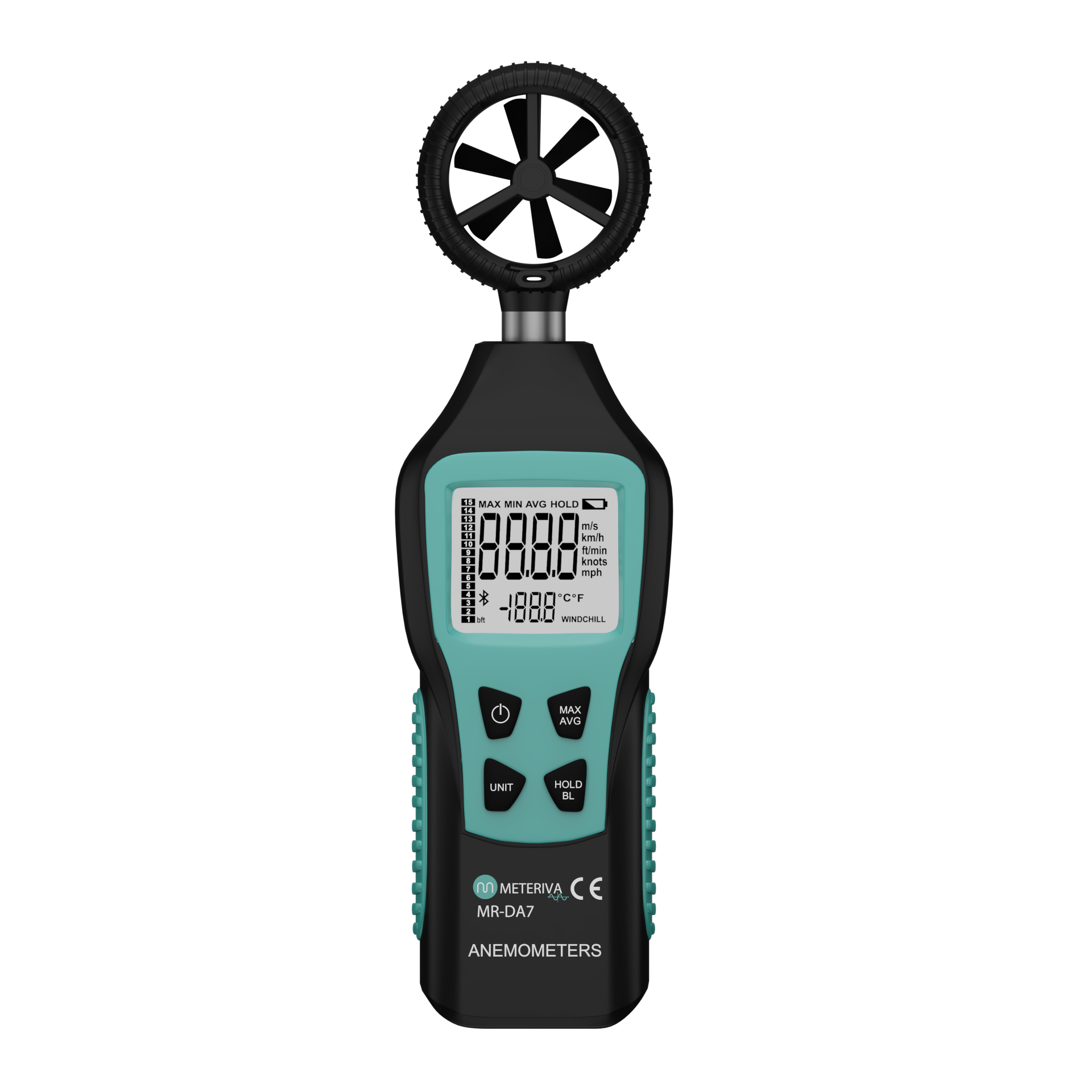Digital Anemometer
An Digital Anemometer measures wind speed.
METERIVA Digital Anemometer are crucial devices used for measuring wind speed and air pressure. Based on the specific application, the anemometers can be hot wire or pocket weather anemometers. These devices can store the data measured in their internal memory, subject to the model. Anemometers come in different type to match specific requirements. Some of the anemometers included are hot-wire anemometers, vane anemometers, cup anemometers, or portable, waterproof anemometers. These miniaturized devices can be used for quick and instant measurements of air velocity and volume flow.
Digital Anemometer In Use
Purchase Advice on Anemometer
Anemometers, which takes its name from the Greek word anemos (wind), are primarily used for measuring wind speed. As seen in the measurements presented, the data is standardized at a 10 meter elevation. It is due to the very pronounced variations of the ground wind velocity in the immediate surroundings. A particular anemometer measuring method could depend on the type of the anemometer and the environment. We can measure wind speed using heat sensors (hot wire), spinning wheels (mechanical), or pressure gauges (pitot tubes).
The most recent technology in this domain relies on ultrasound. Nevertheless, these devices tend to price higher for their additional features. Anemometers are the multi-purpose devices that play the key role for many applications starting from meteorology to wind energy. Being extremely precise instruments for measuring wind speed and air pressure make them un-replaceable in these areas.
Wind Energy Projects
Measuring devices, called anemometers, are essential elements of wind turbine projects. A mere difference of 0.1m/s in sustained wind speed during long term period may determine the feasibility of a proposed project. Consequently, procuring the best anemometers, considering their price, is of utmost importance. Among these instruments some come with a data logger function, which helps in keeping data measured for later use. Subsequently, we transfer this data to a computer for easy storage and analysis.
Understanding Anemometers: Types and purpose
Thermo Anemometer / Hot-Wire Anemometer:
Thermo anemometer, or wire anemometer, works in such a manner that a sensor element is heated using electric current. The electrical resistance of the part experiences changes when it gets heated up. The wind or air flow carries this heat away. The rate of transfer of heat is directly proportional to the velocity of the air flow. Such a voltage enables the hot-wire anemometer to infer the flow rate by means of these electrical parameters, that is how anemometer measure wind speed.
A wire anemometer may be created as a sensor made in the same way as a hot wire anemometer. Film sensors may be thinner and have the same type of work. Ensure thermo anemometer readings consider wind direction, as it directly impacts results. Typical sample is hot-wire sensors that are almost a standard in leakage diagnostics of blower doors i.e; it is most often used for blower door measurements.
Vane Anemometer:
Vane anemometer detects airspeed through capturing rotational momentum that comes from wind passing across its vanes. This will consequently get displayed on the device as the rotation. As an example, the electronic devices the vane anemometer is used with receive measurement impulses from a forked light barrier. One disadvantage of vane anemometer is the start-up speed of the driven vanes which needs a certain wind velocity. In contemporary setting, where vane anemometers are designed to be as tiny as possible, this frictional force can be clearly minimized. Nevertheless, there is one shortcoming of a vane anemometer which is the inability to measure the wind speed that is independent of the wind direction. Vane anemometers are commonly used by sailors and pilots while playing sailing or aviation sports, that can be stated to be a characteristic anemometer use.
Pitot Tube Anemometer:
A pitot tube anemometers processes the wind speed that is based on the differential pressure. It positions the nozzle to record the pressure which hits the pitot tube and the pressure which is around the tube. Through measuring this difference in pressure and monitored with a conversion into flow velocity the pitot tube’s anemometers can provide the velocity sensing for you. Pitot tubes are tools for measuring velocity, especially in those cases when they are extremely high. Their application in aviation and motor driving is really common. The direction of the anemometer to the direction of the wind is always at the lower sensor node of the anemometer.
Due to the fact that there are many kinds of anemometers, each with its own particular method of computation of wind speed and direction. The selection of anemometers is usually application specific and depends on where and how the sensors will be used so that, the anemometer measure the wind speed properly.
Cup Anemometer:
Cup anemometers represent an instrumentation technique for speed modulation of wind irrespective of the direction from which the wind comes from. As they are based on the same working principle of a Vane Anemometer, wind hitting any of the half-shells of the device causes rotation around its center of gravity. Through generating momentum, this motion is then changed into the electrical output by using electronics. The wind velocity, are generally visible either on an LCD screen or on the side of the monitor. The anemometers in cups are often used for determining speed of winds and used for establishing wind power stations. The anemometers in cups are commonly used in meteorology and for assessing wind conditions before setting up wind power stations which is another important anemometer use.
Ultrasonic Anemometer:
A cutting-edge technique of an ultrasonic anemometer is to have four different ultrasonic transmitters and receivers. The wind streaming across ultrasonic elements bring a slower speed in wave propagation. It is such a measurement of lag between the appearance of the successive puffs of the air that permits the anemometer to calculate the avenging velocity. The strength of ultrasound anemometers compared to the traditional ones is that they do not have the need for replacement parts. Furthermore, Lidar can accurately measure both the flow velocity and the flow direction with precision. What’s even more striking is that using new technology like ultrasonic anemometers has spread to many fields like meteorology, agriculture, and shipping. However, incorportation of these additional make the devices price higher.
General Usage Guidelines
In addition, many anemometers accurately measure flow parameters, displaying real-time data, including temperature and volume changes. This feature eliminates the need for complex conversion formulas by containing built-in measurement calculations. It must also be noted that the probe (being this a pitot tube, a thermal flag or a propeller) must be kept steadily and in the direction of the flow, that is how anemometers measure wind speed.
Elliptical commutation is possible only for devices with average calculations. This method guarantees the best results in the middle of the current line. Most anemometers are equipped with directional arrows, and it is therefore crucial to follow the enclosed instructions on usage. If the sensor has been placed in the wrong direction in the streamline then that will result in an inaccurate reading, or the anemometer can be damaged.
By illustrating this, we can see that the devices with impellers can get damaged through improper usage since their impellers have a fixed direction in which they run. Another factor to consider is to make sure there are no dust particles in the air being measured as the thin flags can get easily damaged during motion from the particles.
As the sensor is the focal point which is also the most valuable and costly part of the sensor, therefore, device will not come into use if the sensor get damaged. For low conductivity media, a vane anemometer or a pitot tube anemometer should be chosen in order to measure velocity higher than 15 km/s. These devices are very accurate, strong, and capable of measuring over a wide range of velocity, which is one of the key anemometer uses. However, the price of these devices can vary depending on its features and capabilities.

